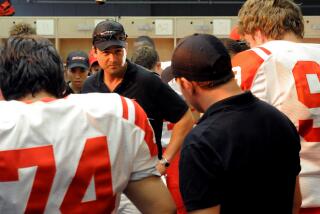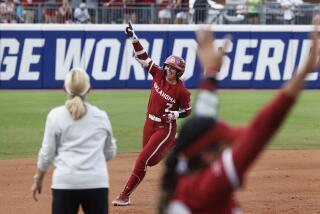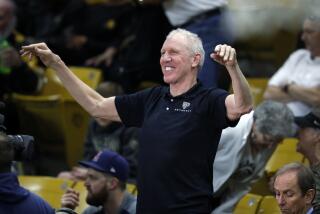Reformin’ Norman
NEW ORLEANS — The University of Oklahoma’s football roots in the soil north of the Red River run so deep that the school played its first college game in 1897, a full decade before Oklahoma moved from territorial status to statehood.
Passion for Sooner football has been so strong for so long that in 1915, hundreds of fans stood in a downpour outside a Norman drugstore to hear the telegraphed play by play of a game against Missouri. In 1928, the school shut down for a day to observe a funeral for the team mascot, a dog named Mex.
You’d be hard-pressed to find a program richer in tradition and with a more colorful past than Oklahoma, even if those hues, during a seemingly lawless period in the late 1980s, were sometimes more checkered than crimson and cream.
Oklahoma, after all, gave us a university president, George Cross, who said he “would like to build a university the football team can be proud of,” and a coach, Barry Switzer -- the son of a bootlegger -- who described Norman as “a drinking town with a football problem,” and a cocky linebacker, Brian Bosworth, whose mother, Kathy, once said, “It’s a good thing Brian was a third child, or he would have been the only one.”
Oklahoma gave us the Sooner Schooner, a horse-drawn covered wagon that circles 81,000-seat Memorial Stadium, and an All-American halfback named (appropriately) Joe Don Looney, whose penchant for guns and fighting and his refusal to practice led to his dismissal from the team after one great season in 1962.
Looney, once projected as the next Jim Brown, played six years in the NFL before a stint in Vietnam. He drifted to India and Peru to study Eastern religions, was once found broke and living in a dirt hovel near San Antonio, and before his death in a 1988 motorcycle accident, discovered some peace as a disciple of the mystic Muktananda.
Oklahoma has also won or shared seven national championships, three each under legendary coaches Bud Wilkinson and Switzer and one under current Coach Bob Stoops, whose Sooners will shoot for No. 8 when they play Louisiana State in Sunday’s Sugar Bowl.
The Sooners have won 38 conference titles, they have produced four Heisman Trophy winners, including quarterback Jason White, who will start against LSU on Sunday, 135 All-Americans, six of whom will suit up against the Tigers in the Superdome, and a 47-game win streak that still stands as the NCAA record.
Oklahoma has won 493 games since World War II, more than any other NCAA Division I school, and the Sooners played in what is widely considered the greatest game in college football history, a 35-31 loss to Nebraska on Thanksgiving Day, 1971.
“Oklahoma has always been one of those giants of college football,” said Switzer, who is retired and living in Norman. “You look at the traditional greats -- Notre Dame, USC, Penn State, Michigan, Alabama, Nebraska -- but of those teams, look at who’s won more games and national titles, who has more conference championships, Heisman Trophies and All-Americans, and Oklahoma is one of the top three programs in the country, no doubt about it.”
Because of its success and because there are no professional teams in the state, Oklahoma football has always been top-of-the-front-page sports news, and Oklahomans have been hitching their fortunes to the Sooner Schooner for generations.
“For some people, it’s a way of life -- they just can’t wait for August to come,” said Jammal Brown, a Sooner offensive lineman from Lawton, Okla. “You can see how important Oklahoma football is to them. The Sooners are like the state’s pro team.”
From the big cities such as Oklahoma City and Tulsa to the tiny towns that dot the monotonous landscape, Oklahoma football permeates through the state.
“I grew up in rural [Ada] Oklahoma on a ranch,” said Dan Cody, Oklahoma’s defensive end. “The closest gas station was 14 miles away, and we didn’t have cable TV or city water until I was in high school, so we didn’t follow college sports much.
“But the one thing I always remember in the 1980s is Brian Bosworth. I had my hair cut like the Boz, the mullet with the colors on the side. Everyone in my grade school did.”
Though most associate the emergence of Oklahoma football with Wilkinson’s promotion from assistant to head coach in 1947, the origins of the Sooner dynasty date to Coach Bennie Owen, who guided Oklahoma to a 122-54-16 record from 1905 to ’26.
The Sooners went 10-0 in 1915 and, using the arm of All-American Forest “Spot” Geyer, were the first team in America to rely on the forward pass for offense.
Oklahoma football went undistinguished for the next two decades, while the state was ravaged by the one-two punch of the Great Depression and the Dust Bowl.
Oklahomans lost farms and businesses, and their struggles were played out in movie house newsreels of “Okies” heading west and the pages of John Steinbeck’s “The Grapes of Wrath.” Cross, the school president at the time, concluded after World War II that a strong football program could build the esteem of the university while enhancing life in the community.
Wilkinson, a regal 30-year-old Minnesota graduate with a master’s degree in English education, took over in 1947, and in the next 17 seasons, the Sooners went 145-29-4, posted the 47-game winning streak and won three national titles.
“What did Oklahoma have to be proud of after the war?” said Switzer, who grew up in neighboring Arkansas. “Everyone from Oklahoma, Arkansas and Texas went to California to look for work. All these Okies had nothing else to hang their hat on.
“There was poverty, the agriculture was barren, there were no beaches, mountains, Hollywood. George Cross had a vision to recognize we needed something to be proud of, and he created the monster.”
Switzer calls the program a “monster” because Wilkinson, who introduced the 5-2 defense and won consecutive national titles in 1955 and ‘56, created unrealistic expectations for his successors, much as former basketball coach John Wooden did at UCLA. But Wilkinson was anything but monstrous.
“He was pretty much a god here in Oklahoma,” said Mike Treps a 1956 Oklahoma graduate who spent 27 years as a broadcaster and sports information director at the school. “The way he was educated, the way he dressed, the way he spoke was second to none. Coming out of the Grapes-of-Wrath syndrome, he just exuded class. And he won and won and won.”
Under Wilkinson, the Sooners went undefeated in 1949, 1954, ’55 and ’56. Running back Billy Vessels won the school’s first Heisman in 1952.
“Bud Wilkinson and the Sooners were the first real comeback for Oklahoma,” current Oklahoma President David Boren said in a 2001 interview with The Times.
Coaches Gomer Jones (9-11-1 in 1964-65) and Jim MacKenzie (6-4 in 1966) struggled to replace Wilkinson, but Chuck Fairbanks, with his wishbone offense, guided the Sooners to a 52-15-1 mark from 1967 to ‘72, an era that included running back Steve Owens’ Heisman-winning 1969 season.
When Fairbanks left for the New England Patriots, he was replaced by the assistant who had persuaded Fairbanks to switch to the wishbone in 1970 -- Switzer, the recruiting whiz who led Oklahoma to a 157-29-4 record and three national championships in 16 years (1973 to ‘88).
Switzer’s teams were fast, exciting and athletic -- remember Joe Washington, 1978 Heisman winner Billy Sims, Jamelle Holieway? -- but character sometimes took a backseat in recruiting.
In a mind-numbing two-month period in the winter of 1988-89, Oklahoma was put on three years’ probation for major violations, which included offering cash and cars to recruits and giving airline tickets to players; three players were arrested for allegedly raping a woman in an athletic dormitory, one player shot a teammate in the chest, and star quarterback Charles Thompson was busted for selling cocaine to an undercover agent.
“I dreaded picking up the telephone every time it rang,” said Treps, the school’s SID at the time. “What’s it going to be next?”
Switzer resigned in June 1989, and so began Oklahoma’s Dark Ages. His successor, Gary Gibbs, restored order and had a respectable 44-23-2 record in six years. But his record was a combined 2-10 against Texas and Nebraska. He had trouble recruiting and resigned under pressure after 1994.
“He was getting letters from parents telling him not to recruit their son, because there was no way he’d be going to Oklahoma,” Treps, now 70 and retired, recalled. “It was because of all the problems under Switzer.”
Howard Schnellenberger alienated many in Norman and was forced out after posting a 5-5-1 mark in 1995, his only season, and his replacement, former Dallas Cowboy assistant John Blake, was a disaster. The Sooners were 12-22 from 1996 to ‘98, giving up 50 points or more in five games, and Blake was fired after three seasons.
“I couldn’t believe they were getting half a hundred hung on them,” Switzer said. “That stuff was unheard of. We used to do that to people.”
Asked if he had any regrets about the way his Oklahoma tenure ended and the problems left in his wake, Switzer said:
“Heck, yeah, there are three or four players I wish I never recruited. The guy who shot his roommate [Jerry Parks] visited Notre Dame and Texas A&M;, but I beat them recruiting. That was one of the team rules, don’t shoot a roommate, but it happened.... There were hundreds of great young men in the program, and three or four guys screw up and taint everyone. It’s not fair.”
By the end of the Blake error -- OK, era -- Treps said, Oklahoma football “had hit rock bottom.”
“There were a lot of alums who went to games hoping we’d lose so we could get this guy out of here,” Treps said.
Enter Stoops, the former Florida defensive coordinator whose father, Ron, was a respected high school coach in working-class Youngstown, Ohio.
“When we got here [after the 1998 season] the players had very little self-esteem, very little self-confidence, probably none, and a very poor self-image, and it permeated throughout the community because reporters, writers and the school didn’t look at our program in a very positive light,” Stoops said. “There was a lot to change but, fortunately, we got it done pretty quickly.”
Pretty quick? Try cable-modem quick. Oklahoma, behind the energetic and exuberant Stoops, went 7-5 in 1999, losing to Ole Miss in the Independence Bowl, and 13-0 in 2000, beating Florida State for the national championship.
The Sooners were 11-2 and won the Cotton Bowl in 2001, 12-2 and won the Rose Bowl the next season, and they were 12-0 this season before losing to Kansas State in the Big 12 Conference championship game Dec. 6. They have an explosive offense and a star-studded defense that is regarded as the best in the country.
“To me, Bob and his staff have done the best coaching job I’ve ever witnessed in college football,” Switzer said.
“He’s brought Oklahoma back to the pinnacle.”
And he’s kept it out of the gutter. Stoops, 43, has maintained a squeaky-clean image while rebuilding the Sooners. Players have had a few minor scrapes with the law during his tenure, but Stoops hasn’t had to suspend anyone.
Now, the parents of top recruits are eager to send their boys to Oklahoma, which seems poised to remain among the sport’s elite for years. Once again, there is a mystique about the Sooners, an aura of invincibility.
“It’s exciting to be a part of getting Oklahoma back to perennial dominance,” Cody said. “Everyone knows Oklahoma football now. We’re on the map again.”
More to Read
Go beyond the scoreboard
Get the latest on L.A.'s teams in the daily Sports Report newsletter.
You may occasionally receive promotional content from the Los Angeles Times.











